One of the unfortunate casualties of my recent blogging hiatus was that I left the account of my trip to Oman unfinished. Once you’ve reminded yourself of the story so far (Part 1, Part 2), let’s continue the parade of pretty photos.
Day 10. Today started out with another long car journey – this time to the northwest corner of Oman. We skirted to the north of the Wahiba sands, a massive sea of sand dunes, all of which seem to be gradually moving north-east and threatening to engulf the highway. Many of the telephone poles at the roadside were already half buried by sand, indicating an ongoing and fairly rapid migration.
In order to reach today’s sampling target we had to put ourselves completely in the hands of our Omani colleagues, and a GPS, and drive out into the desert to reach an inlier of 800 million year-old basement riddled a swarm of igenous dykes.

Igneous rocks are very useful for paleomagnetic studies, not only because they’re chock full of magnetic minerals but because they are much easier to date – and knowing the age of the magnetic signal is pretty important if you’re trying to reconstruct tectonic movements over time. Interestingly, the best rocks for palaeomagnetic studies are the finer grained parts near the faster-cooling margins, but for radiometric dating you want the larger mineral grains in the slower-colling centre. So because we wanted to date these dykes, double the weight ended up in the back of our Landcruiser.
Day 11. We stayed overnight near the coast of the Arabian Sea, and were treated to a spectacular sunset over the sand dunes (which I didn’t photograph due to driving), and a spectacular sunrise from the water, which I did.
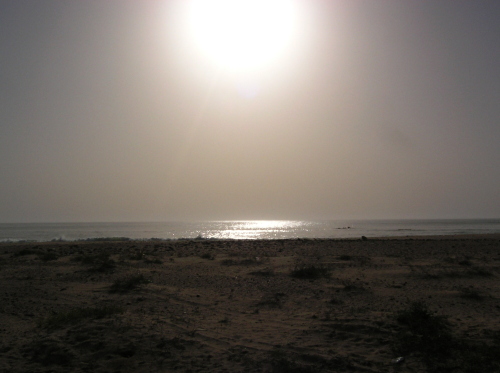
In a bizarre “small world” moment, I realised that if you head out to sea from this point to the edge of the continental margin, you’ll get to the sampling site for a sediment core that I’ve done some work on, and published a paper about, at the beginning of the year.
Before heading back to Muscat, our Omani colleagues were quite keen for us to sample a 380 million year-old Devonian carbonatite, a mineralogically unusual igneous rock rich in carbonate minerals. All of the small hillock-like outcrops breaching the flat surface of the wadi appeared to be the eroded remnants of a large volcanic plug.

On closer inspection, there appeared to be quite a lot of magnetite in this rock: no cause for complaint there, although strongly magnetic rocks are not always the most useful ones, not least because they have a habit of overloading our nice sensitive magnetometers.
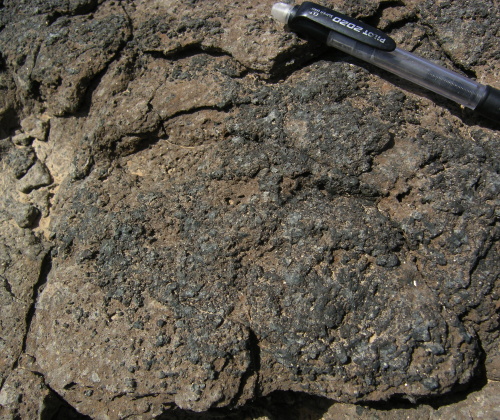
This was in many ways a target of opportunity – it wasn’t something I’d planned to sample, and it was also much younger than everything else we were looking for. But it was there, and our Omani friends are interested in what was going on tectonically when it erupted, so it might well yield some interesting results. After all, you can never have too many samples!
Day 12. Back in Muscat, we spent a relatively uneventful day preparing to fly down to the very south of Oman for the final lot of sampling. This involved unloading all our equipment and samples from our trusty Landcruiser so that we could clean it before returning it to the rental company, imposing the stuff that we didn’t immediately need on our friends at the University, and trying not to get into too much trouble.
Day 13. An early start allowed us to fly all the way to Salalah, right over the other side of the country near the Yemeni border, by lunchtime. We then picked up our latest field vehicle.

Yes, our other car was a Hummer, and I can’t say I was entirely impressed with it – for all its bulk, it’s extremely cramped and the windows were exceptionally small (a nod to its military lineage, I suppose). Besides, it was an automatic, which did not predispose me to being a fan.
After picking up some subsidiary equipment that we could not fit on the plane – mainly tanks for drill cooling water – we managed to get right out into the field for another afternoon of sampling Snowball Earth carbonates.
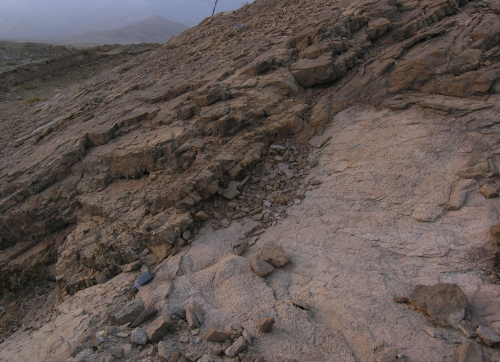
In contrast to the previous examples, this carbonate was directly laid down on granite rather than overlying the supposed glacial diamictites. They are certainly present, but their distibrution is patchy – they appear to be filling in the valleys, possibly carved by glaciers, of an ancient Precambrian landscape. The higher ground was left bare, until the carbonate was deposited in a period of higher sea-level which drowned the entire landscape.
Our reward for a hard day’s sampling was a rather spectacular sunset. As in the north, the high mountains are mainly Mesozoic limestone.
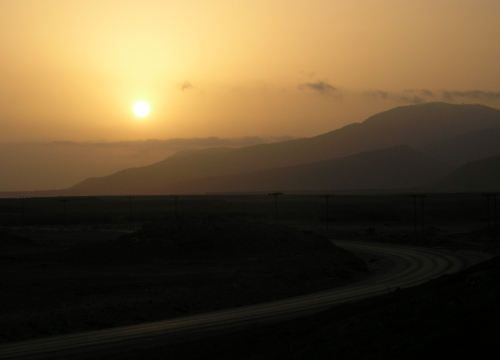
Day 14. Our main motivation for visiting the south is that you can find the largest chunk of exposed basement in the country; and as in the north, that basement rock is riddled with dykes.

It’s quite a spectactular landscape: the granitic basement itself has almost been eroded down to sea-level, and the more resistant dykes form elevated, linear ridges of darker rock.
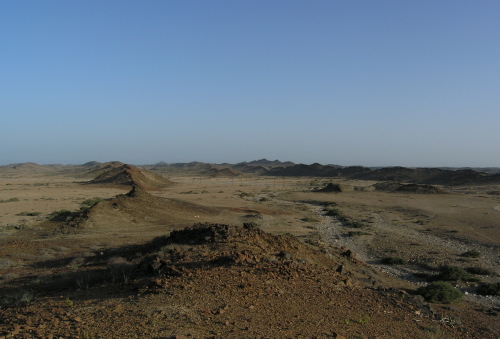
A satellite view shows just how numerous these dykes are.
Dating so far indicates that the entire dyke swarm was intruded between 700 and 750 million years ago, right at the start of the ‘Cryogenian’ period that covers the alleged Snowball Earth events. We sampled as many different dykes as we could; the only stumbling block was that we were drilling extremely hard rock, which was quite expensive in terms of time and water (we had to return to civilisation to refill the water tanks a couple of times).
Day 15. Our last day of fieldwork proved to be somewhat disappointing. We wanted to find another outcrop of cap carbonate, this time where it was deposited on top of diamictite. Finding the diamictite wasn’t too hard: we just drove inland and discovered hills of the stuff.
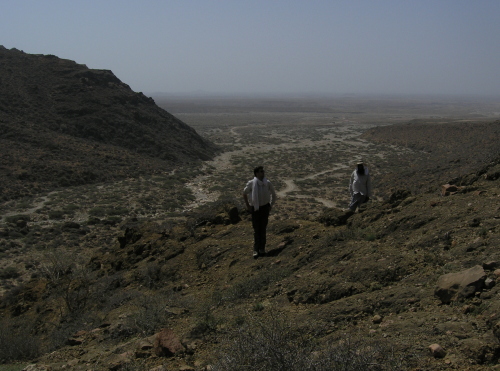


In the final image, the crags in th top 1/3 of the hill mark a transition to massive sandstones, and hence if there is any cap carbonate that is where it would be. Despite a couple of hours’ worth of sweat- and dehyrdation inducing scrambling in the scorching sun, we were unable to find it. In the end, I was actually quite glad, because getting up to the contact was hard enough when I was just carrying myself, let alone a drill and gallons of water.
During my clambouring, I was also on the look out for definitive evidence of a glacial origin for the diamictites – thinks like striations carved onto the larger rock clasts by the moving ice. Unfortunately, I was unlucky there too – although partly that was because many of the clasts are granite and gneiss eroded locally from the basement, which are not the best starting material for such things.
The one advantage of this rather anticlimatic finish to our mad dash around Oman was that before flying back to Muscat that evening we could afford to go a bit tourist. On the way back to Salalah we ate at an excellent fish restaurant in the traditional fishing village of Mirbat. Although, situated on a lovely little fishing harbour, this place has seen better days; it seems that rather than rebuild after a significant amount of damage was caused by a cyclone several years ago, the government has been moving the population to a new, much less picturesque settlement, further inland.

We also drove up into the mountains above Salalah, where I was probably the coolest I’d been since I arrived in Oman (it was below 30 C, I tell you!) and I got to drink out of a coconut for the first time. Before boarding the plane back to Muscat, we gave our magic export letter a first (successful) test run when the x-ray machine indicated that our souvenirs were a little out of the ordinary.
Day 16. It’s unfortunate that your last memory of any country you visit in the name of fieldwork is usually the cargo terminal of an international airport – difficult to get to, not exactly brimming with cheer, and staffed by people who flip between puzzled (you want to ship rocks? And suspicious (what exactly is in these rocks?) This time, we managed to get through two layers of bureaucracy before someone decided that despite our magic letter, they wanted us to unpack our 64 kg, bulging at the seams case of rocks for a visual inspection. On the whole, though, the Omanis were as helpful as ever, and it actually cost far less time and money that I was expecting to send our geological bounty homewards, giving us a few hours to relax before we took to the skies ourselves.
Day 17. After the usual indignities of an overnight flight in economy class, we landed back in Edinburgh. Blessedly cool, overcast, drizzly, wonderful Edinburgh. And it was then that the real work could begin: turning our samples into useful and exciting data. Well, that’s the plan, anyway…



Comments (2)